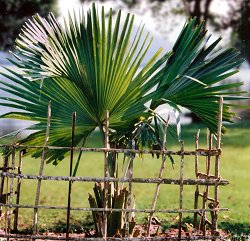
APPENDIX (I)
Manuscript writing material: palm-leaves.
It is clear that in the ancient world manuscripts and paintings were done on a wide variety of materials such as birch (a tree grown in northern hemisphere)-bark, papyrus (reed-like trees grown on the banks of Nile River) clay tablets (on which Babylonians were forced to write) and palm-leaf manuscripts including paintings, on cloth and paper.
Manufacture, preparation, writing and painting of palm-leaf (known as Ola in Sri Lanka) manuscripts are also, particularly, an art and science in South and South-east Asian countries including India, Sri Lanka, Burma (Myanmar) Thailand, Indonesia, Lao and Kampuchia (Cambodia). The manufacture, preparation, writing and painting of palm-leaf reflect individual, territorial and cultural identity, distinct style, techniques and patience and dedication.
Before the introduction of paper, palm leaf was the main raw material used for writing and painting for several centuries. There are large collections of palm-leaf manuscripts in several museums and libraries in South and South-east Asia, as well as in western countries. Hundreds of thousands of palm leaf documents have come down to us in the form of our ancient wisdom and heritage. It will not be out of place to mention that the manuscripts themselves were treated as objects of worship and not only as religious texts.

A palm tree

An open bud of a palm-leaf
The fundamental properties that is worth considering of the palm-leaf
In the palm-leaf there are two main parts. One, like a thick wall on the surface of the two sides, and the other, the inner part. The surface part is known as the epidermis. It is smooth and rather thick and rests on the inner portion, which consists of mesophyll traversed by a vascular system. The epidermis is securely fixed to the inner part but there structures are different. The surface layer is smooth and is less absorbent than the inner portion. The inner part of the leaf has thin wire-like veins that almost intertwine with each other. This structure provides strength for the palm-leaf. If a deteriorated palm-leaf is viewed under a stereomicroscope, this type of structure can easily be seen.
There are many varieties of palm trees. However the leaf of only a few has been used for writing. The most widely used were Borassus Flabellifer Linn (the palmyra palm), Corypha Umbraculifera Linn (talipot palm, fan palm) and Corypha Faliera Roxb.
The kind of Borassus Flabellifer Linn grows in many parts of India, Myanmar, Sri Lanka and native to tropical Africa. It needs a comparatively dry climate. The tree attains a height of 15-20m and the trunk is 1-2m in diameter. The leaf stalks grow up to a length of 1m. They are fibrous and initially strong and flexible; however with time the natural flexibility decreases. The leaves of the palmyra palm are rather thick compound to those of the talipot palm. The palmyra palm, Borassus Flabellifer Linn, is mostly used in writing letters and notes and not in the writing of important books. They also appear to be more prone to insect attack than the talipot palm are.
The talipot palm or fan palm (Corypha Umbraculifera Linn) is an erect tall tree that grows to a height of 20-25 m and has a trunk 0.5-1m in diameter. It needs a wet climate and grows abundantly in moist coastal areas. It is found in the forests of Sri Lanka, Myanmar, Thailand, Malaysia and South India. The leaves are soft light coloured when dry and flexible. Practically, all books of value are transcribed on the prepared leaf of the Talipot palm (Corypha Umbraculifera L.).Corypha is one of the largest of palms and grows in Sri Lanka (seen at the Peradeniya Botanical Garden in Kandy). The time for the full growth of the tree takes from forty to a hundred years. Before the tree dies, it shoots out from its top an inflorescence to a height of over twenty feet. Presently, the Talipot palm (Corypha Umbraculifera L.) tree is fast disappearing due to deforestation and urbanization. At the same time, neither commercial value is attributed to the tree and nor an effort is taken to replant it. Today the main use of the leaves is in making handicrafts; fans, mats, umbrellas, baskets, wicker trays and for thatching. White umbrellas made of pieces of talipot leaves and mica is a fine decoration used as the insignia of royalty. But lately it was used as a symbol of prosperity.

palm-fans used by Buddhist monks for holding Buddhist talks and chanting Pirit by pairs of monks using a palm book

A palm umbrella used by a Buddhist monk

White umbrella used as a insignia of royalty, and lately as a symbol of prosperity is a fine decoration made of pieces of palm-leaf and mica
The Corypha Taliera Roxb is a strong palm tree, growing to a height of about 10m and having a trunk less than 1m in diameter. The leaves are slightly brown in colour with black spines. This palm grows mostly in Bengal and some coastal areas of Tamilnadu in India. The leaves of Corypha Taliera are thick and not very flexible. They are also prone to eaten by insects.
It is difficult to say exactly when the palm leaf first began to be used in writing. A fragment of the text of the 2nd Century AC Indian drama had been discovered in Central Asia. However, India has no extant palm-leaf manuscript from before the 10th Century. Today, India possesses an extremely important and large collection of manuscripts written in Sanskrit, Tamil, Telegu and English on all aspect of art culture and literature.
Palm-leaf manuscript writing in Sri Lanka began from the 1st Century BC, with the Fifth Buddhist Council held at Aluvihāra.
For twenty consecutive centuries the palm-leaf manuscripts diffused to every corner of the country. In the latter period, palm leaf manuscripts were written in Pali, Sinhalese , Sanskrit ,Tamil and English(during the British Colonial regime) on all aspects of art, culture, language and literature.{Ayurvedic medicine, love songs, acupuncture treatments, incantations and charms(yantras and mantras) recipes etc.}
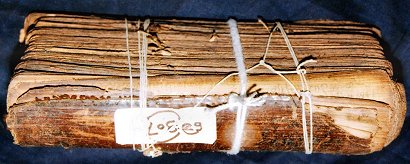
An Ayurvedic book
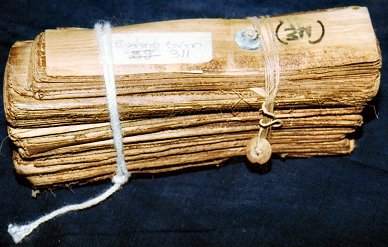
A spell book
Paper was introduced to Sri Lanka in 1606 during the Dutch period. Already Sri Lankans did not know “How to produce paper for writing”. Captain Robert Percival, says in his work titled An account of the island of Ceylon composed in 1803 that “They use these palm-leaves, instead, for that purpose.” “For exchanging letters with Europeans they used the prepared leaves in that manner” “Sometimes Sinhalese use some kind of pulp-like-matter made of barks of the trees for writing.”

Written palm-leaves
Processing of palm-leaves in Sri Lanka
In order to make them suitable for writing, palm leaves had to be processed in a special manner. Several processing methods were used. Processing differed from area to area. Palm-leaves are found in varying sizes, sometimes as long as 1m. However, the width is almost always small, not more than 8-10cm. This fact imposed a limit on the format of the manuscript, as well as on the dimensions of the paintings.
First, the tender bud should be cut from the crown of the palm tree and it should be let down to the ground very carefully.
The sub sections should be separated and the midrib of each leaf is cut off and leaves become flexible stripes, a hole is made at the each of the leaf strips making it easy to hang up later. They are then formed into rolls by winding them in concentric circles.
The leaf rolls are placed in a large clay vessel to form a layer. On top of this, sliced papaw (Carica Papaya) nuts and pineapple (Ananas) leaves are placed. Thus another layer of leaf rolls are placed and so on alternately, till the pot is almost full. The pot is filled with water and Keppetiya(Croton Lacciferus) leaf branches are placed and the vessel is closed tightly with an earthen lid. A cloth is tied to seal it. Then it is placed on three earthen bricks and firewood from the forest is used to heat the pot.
Medieval people used a simple device to measure whether the leaves had boiled to the correct temperature. They opened the vessel and shook the Keppetiya (Croton Lacciferus) branches. If the leaves fell off they considered the palm leaves sufficiently boiled. They came to the same conclusion if sliced papaw nuts are over cooked by boiling. They then took out the leaf rolls and washed them in pure water.
The leaves are kept loosely out of doors exposing to breeze and in turn, sun for a day or so in order to dry well.
Next, a cord is hung out in
the garden like a clothesline and the strips are placed over the cord to catch
the dew in the early morning. Care is taken to see that they do not get mildew.
The leaves are exposed to mild sun for several hours and are wound in concentric
rolls again in dried condition and can be stored.
The next stage is the polishing of the palm leaf strip. A long round pole of Ruk-attana (Alstonia Scholaries) trunk is used. This is tied to two rods and placed six feet above the ground. A stone, one pound in weight is tied to one side of the leaf strip. Leaf strip is absorbed in water for several minutes before polishing. The leaf strip is placed over the wooden pole with the stone end hanging down. Next it is rubbed up and down on the pole till the leaf strip get flattened smoothening the wrinkles. Similarly, all the leaf strips are made so.
The forming of palm leaf strips into a bundle is also a special process. The leaf strips are punched with two holes on either side to pass a cord according to the following old stanza.
“Ayamēna caturbhāgam-Tribhāgam punarēvaca
Ubhayāhk sūtra Madhyēna-Tathā kuryāt chiddra laksanam”
The leaves are placed one under the other pressing tightly together through two bolts, bolted and are cut into required size putting in a Kitul (Caryota Urens) wooden mould. The four sides of the bundle are signed with a hot iron rod to ensure that the leaf folios are the same size and out of the reach of moth eating. At the same time, the two punched holes are too, burnt with a hot spike.
The scribe, usually a monk or a scholar, uses a stylus for writing. The scribe places the leaf strip on the palm of hand, as it is easier to gauge the pressure needed for writing. The letters are written from left to right and the scribe uses the parallel lines of the veins of the leaf to guide him to write straight. With the left thumb, which is placed on top of the leaf, he guides the quill along the lines. Letters are uniform and evenly spaced. Sometimes two or more leaves were stitched together at the edge to make a broader writing surface. The stitching was done with needle and thread.
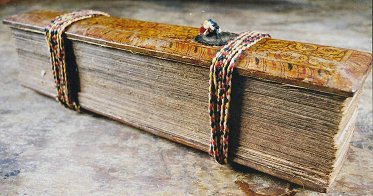
Palm leaf manuscript books in elaborately carved covers
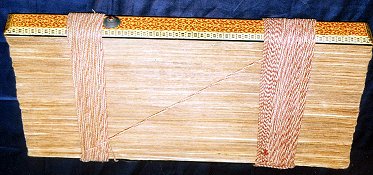
The Jātaka story book containing of 500 stories of the Buddha’s past existences written on palm-leaves
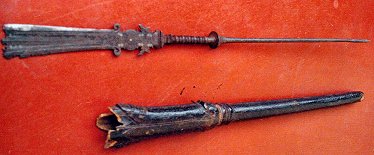
An old stylus with the steel tip to scribe on palm-leaves and its sheath
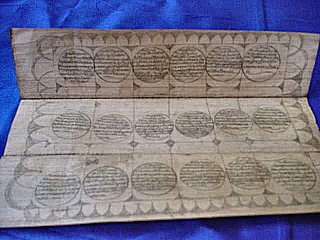
An illustrated palm-leaf
The inking of manuscripts is a special art. The letters etched with the stylus are colourless and therefore difficult to read. So it has to be ‘inked’ in a special manner. For this Gaduma(Trema Orientails) charcoal powder is used. It is mixed with Dummala (resinous) oil and Kakuna(Kakoona Zeylanika) oil.
Leaf surface is rubbed with a wad of soft cotton cloth dipped in the resinous oil and Kakoona Zeylanika oil mixed with charcoal. Resinous oil or dummala tel in turn, helps to increase flexibility of the palm-leaf and to deter attack by insects. It is left to dry and then the leaf surface is cleaned with Kurakkan(Elusine Coracana) powder. This powder absorbs the excess moisture and the excess black colouring. The letters on the palm leaf then appears dark black and the words are distinct and easy to read.
Palm-leaves could not be bound like a normal book. The folios are enclosed in two wooden panels made of Kolom(Adina Cordifolia), slightly larger in size than the leaves, which are usually of hard wood, ivory, silver embossed , lacquered or mother-of-pearl inlay work with beautiful geometrical or floral design on them. Sometimes they are studded with precious or semi precious stones and they are excellent works of art. For identification, a slip of palm leaf (or sometimes of ivory or wood) carrying the title of the work was placed over the cover of the manuscripts. The volume is bound passing a cord through the left punched hole giving the finishing touch to the volume and are generally wrapped in cloth to keep it free of dust.

A stylus with the right proportions
Specific techniques and artistic ways used in communication
Man did not learn how to write all at once. His early attempts were very crude. First, he used bodily expressions and words to communicate with others. Next, he tried to say what he wanted by means of pictures, symbols and special illustrations. These symbols and special illustrations were cut or embossed on the facades of the rocks and on huge trees using various instruments. Some ancient writings were conserved on clay tablets, brass, gold, and on silver. Earlier, he made no attempt to construct separate words; a picture was made to do the work of a whole sentence or group of sentences. It was as if you tried to describe a football match by drawing a series of pictures representing different incidents in it. Gradually man came to see that it would be more convenient to put together a group of little pictures or signs, each representing a word. For the word ‘tree’ he would draw a little tree, for the word ‘sun’ a picture of the sun. But to write in this way demanded a very large number of signs or pictures. The art of writing was simplified, however, when men, instead of using a sign or picture for each word, began to use one for each syllable, very much in the same sort of way as when, in a picture puzzle, we draw a picture of an ox followed by a man walking through water to represent the word ‘oxford.’ Even this method necessitated the use of a comparatively large number of signs. The simplest method was reached with the invention of the alphabet, in which each sign represents a letter. Only a few of these are needed to make up all the sounds required to construct a word or a sentence.
When considered the specific techniques and artistic ways used in palm-leaf manuscript writings in Sri Lanka the mainly used shapes of letters were elephant, swan and crow shapes. Elephant shapes were big while swan and crow shapes were pretty round and haphazard respectively. Sometimes, lion shape, which is round, could be found. Traditional palm leaf manuscripts were written according to rules laid down in the following stanza.
“Samāni samapādani-Samānsāni sama sirāhk
Aksarāni pratisthavyāhk-mrūduni lalitānica.”
Instead of full stop seen in general writings this snake-like sign (~) was mainly used as the full stop to demarcate paragraphs. It was known as crow’s foot too. As it is hard to place a full stop on the palm-leaf this symbol might have been used. The other symbols used instead of full stop were (a) and (~). There were no other punctuation marks and even there was no space between words in early writings. Due to insufficient supply of palm-leaves, fewer characters were used in palm-leaf-writings. For instance, ‘fm’ was used as a symbol signifying ‘and so on, etc’ to avoid repetition. All manuscripts even those with illustrations started with the 24 consonant of the Sanskrit alphabet and 14 vowel sounds and their combinations, totaling 544 in all were used to number the folios.
Deterioration, conservation and storage procedures of palm-leaf manuscript
The palm-leaf is a natural
organic product. It is therefore very susceptible to different agencies of
deterioration. In several ways the palm-leaf behaves like a wooden panel.
Climatic factors (e.g. variations in relative humidity and temperature), light
and insects have a very marked effect on the palm leaf. In addition, constant
handling and adverse storage conditions act as forces of deterioration.
Several types of defects caused by various deterioration factors can be seen in
old palm-leaf manuscripts. The main defects are 1) stains, 2) discoloration 3)
blackening of the surface, 4) damage by insects, 5) fungal effect, 6) splitting
of the surface layer, 7) cleavage of the surface layer, 8) fading of writing and
9) brittleness and weakening of the leaves.
Stains : Owing to faulty storage conditions, contact with water and accumulation of dust and dirt.
Discoloration : It is noticed that the palm leaves often become brown or black. Sometimes, only a portion near the edges is so discoloured. The main cause of this defect seems to be the oxidation of the leafy matter. Accumulation of dirt could be another cause.
Insects : Since palm-leaf is an organic material, it is easily attacked by insects. A survey on this subject revealed that the only insect feeding on them was Gastrallus Indicus. It is a tiny insect that eats its way through bundles of manuscripts.
Fungus :The growth of fungus on palm leaves is not very common though it tends to occur particularly during the rainy season. Fungi appear on the surface in greenish black colonies. The outbreak can be severe if the leaf gets wet accidentally.
Cracks in the surface : A defect often noticed in palm-leaf manuscripts is the presense of longitudinal cracks in the surface layer.
Cleavage of the surface layer : Another defect, noticed in the palm-leaf is the cleavage of the surface from the main body of the leaf. This happens because of the breakdown of the bond between the surface layer and the other parts of the leaves.
Brittleness : Although fresh palm-leaf is flexible, it gradually loses its suppleness and become fragile and brittle. Sometimes it becomes so weak that even slight bending will break the leaf into several pieces. Some conservators attribute this defect to the loss of some essential oil present in the leaf. However, the main reason for brittleness in the leaf is the breakdown of the leaf structure.
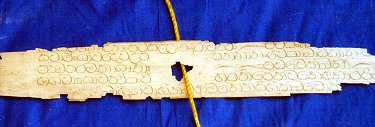
A deteriorated palm-leaf
(II) Conservation
If we follow some simple rules and take proper precautions, the aim of preserving palm-leaf manuscripts can be easily achieved. Our ancestors have been writing on palm-leaves for thousands of years and palm-leaf writing skill is still alive today, though essentially for ritualistic and artistic purposes. South Asians and Southeast Asians together have thousands of palm-leaf manuscripts in their museums, homes monasteries and universities. Thousands of years of Asian wisdom and knowledge are recorded in these manuscripts. Several of these manuscripts are exquisitely illustrated. If these manuscripts are destroyed, all these memories of human progress will be lost forever. Therefore, it is our duty to save them from destruction and damage. The public, the art conservators, the scholars and policy makers have a serious responsibility of ensuring their upkeep and to support the aforesaid institutions to look after these collections properly.
The best solvent for the removal of dirt and other stains from palm-leaf is water. If palm leaf is kept in water for short duration of 15-30 seconds, there is particularly no absorption of water. This indicates that if the palm-leaf is wiped cleaned with swabs of distilled water without being dipped in the liquid for a long period there is not much likelihood of damage. In Sri Lanka dummala tel is applied to the palm-leaf. This application is periodic and is renewed every 2 or 3 years. The oil is dark brown in colour and is non-dying. This oil can be applied even for the brittleness.

Conservation procedure of palm books in an institute in Ahmedabad in India
(III) Storage
Traditionally, palm-leaf manuscripts were always kept between two wooden or sometimes metallic, boards tied together with a cord. The boards were slightly bigger than the size of the manuscript. These boards not only served to keep the manuscript leaves pressed but also protected their edges from damage. For storage in museums and libraries palm-leaf manuscripts must always be kept be between boards. If the boards have been lost at some stage, new boards should be prepared. Some libraries use acrylic sheets as boards. However, aesthetically they are not very appealing.
Another traditional practice for storage was to wrap palm-leaf (as well as paper) manuscripts tightly in a piece of cloth that was often coloured red blue or yellow. This was also a very commendable practice as it protected the manuscripts from dust and, to a greater extent, from variations in atmospheric humidity. Some very important manuscripts were kept in specially prepared wooden boxes. Manuscripts in museums and libraries should also be wrapped in cloth during storage. A square piece of cloth of the appropriate size is used. A ribbon about 1cm wide is attached to one of the corners of the square. The manuscript is wrapped in the cloth and then finally the ribbon is tightly bound all round the bundle to exert an even pressure on the manuscript.
There are several materials used for the lamination of palm-leaves. One of the oldest methods is the use of silk gauze or chiffon (a light see-through fabric). A thin layer of starch paste is applied on the surface of the palm-leaf. Dyed silk gauze/chiffon is placed over the leaf and is then smoothed with the help of a Japanese soft brush
Home | Significance | Access | History | Artifacts | Contact Us | Appendix I | Appendix II | Appendix III
©1996-2011 Copyright Mahendra Gunaratne, Virus Inc. All Rights Reserved www.virusinc.org virusinc@gmail.com +94 777 783468